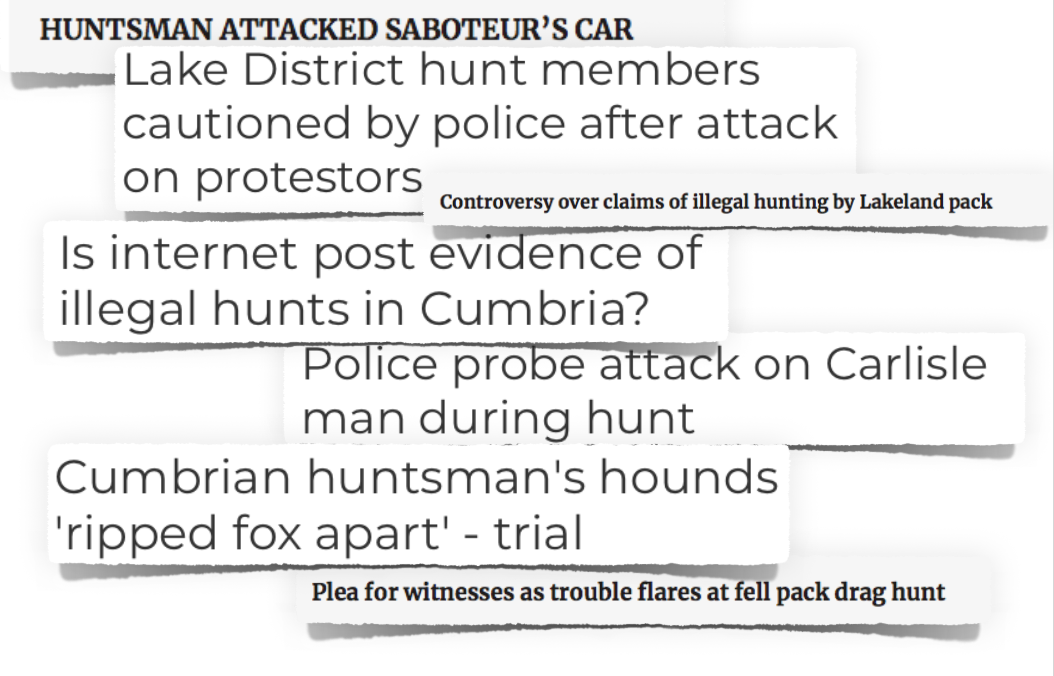13th March 2019
Locals Against the Weston and Banwell Harriers
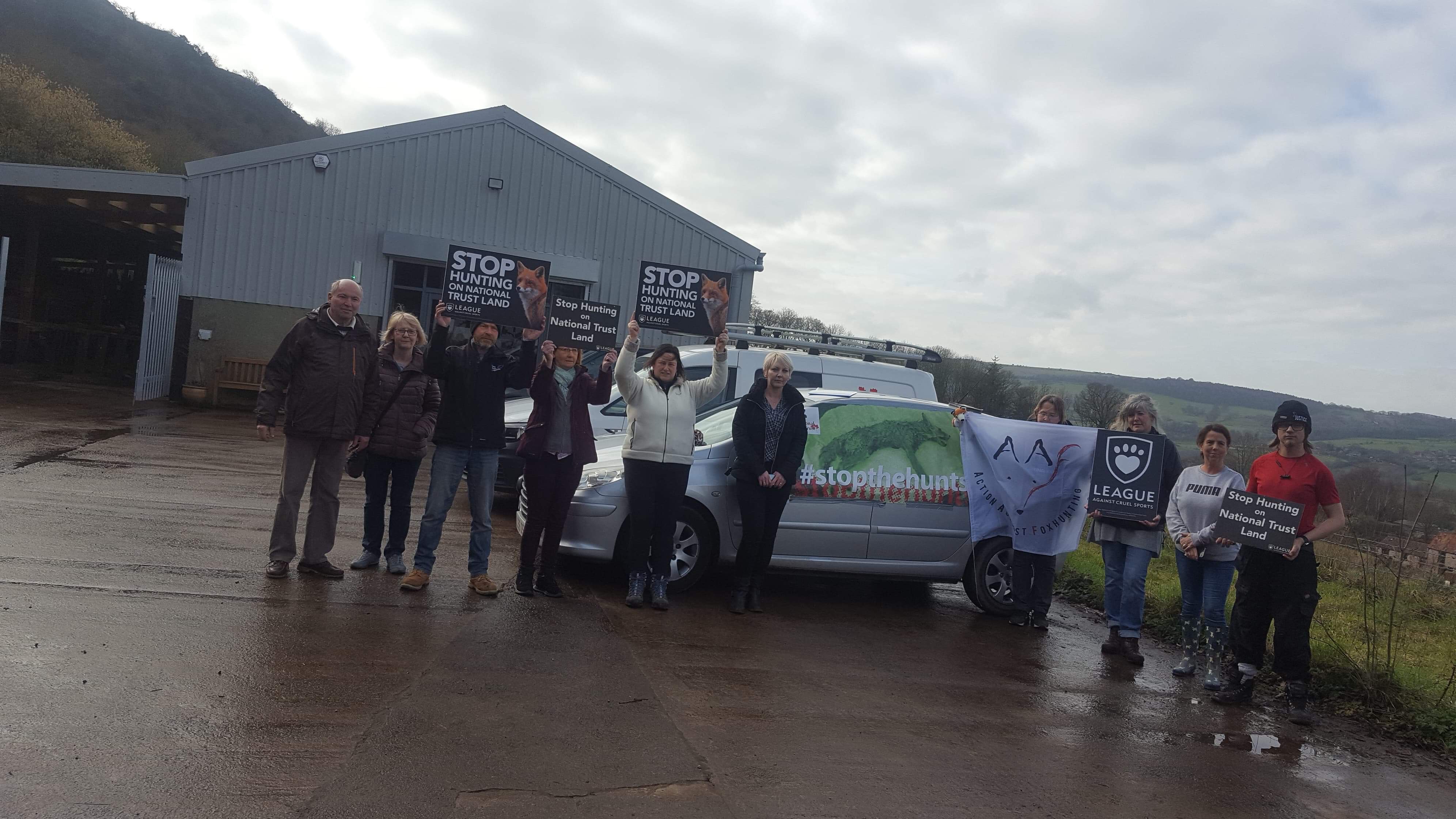 Locals Against the Weston and Banwell Harriers outside National Trust offices at Crooked Peak, Somerset on Friday 1st April 2019. Photo © Locals Against the Weston and Banwell Harriers.
Locals Against the Weston and Banwell Harriers outside National Trust offices at Crooked Peak, Somerset on Friday 1st April 2019. Photo © Locals Against the Weston and Banwell Harriers.
The Weston and Banwell Harriers are a furtive bunch of hunters operating southwest of Bristol. The way they carry on is suspicious to say the least. For instance, why would a legal hunt be involved with blocking badger setts? Consequently, local residents have been trying to persuade the National Trust to withdraw their permission for so-called trailhunting on land which by definition should provide a sanctuary for wildlife.
Locals Against the Weston and Banwell Harriers met with National Trust staff on Friday March 1st. Afterwards, we asked them to let us know their thoughts;
“We attended with Maria Burt who started a petition against so-called trailhunting on National Trust land and set up the meeting, and Jac Freeman from the League Against Cruel Sports. We knew going into the meeting that there was a big likelihood that the licence wouldn’t be revoked but we wanted to give our best shot anyway for the wildlife that calls Wavering Down its home.
“With all our evidence in hand we explained to Nick Droy (National Trust Trailhunting Manager) and the National Trust Wavering Down Team that we didn’t believe the Weston & Banwell Harriers would stay in the rules of the trail hunting licence as they had already sett blocked once this year.
“But sadly and frustratingly this went over their heads and they used the usual excuse that a lot of money had been invested into trail hunt monitoring on their land.
“Giving a hunt notice that they will be monitored just means that they will behave when being monitored by the National Trust.
“How a conservation organisation can support hunting that can and will damage our ecosystem baffles us.
“But our determination to make Wavering Down and Somerset a safe haven for wildlife will continue.
“Hunting is a cruel out of date past time that has no place and is not welcomed. And neither are the Weston and Banwell Harriers, who have been terrorising our wildlife for years unchallenged. Our main aim is to bring an end to this and show them some resistance. We will do all we can to stop them needlessly killing wildlife for sport and fun!
“A big thank you again to everyone that came Friday your support was amazing! And a big thank you to the National Dis-Trust for all the advice and guidance!
“For our wildlife always.”
https://www.facebook.com/localsagainstwestonandbanwellharriers/
Hotline number: 07946663765
Email: [email protected]
© Locals Against the Weston and Banwell Harriers
3rd March 2019
Staghunting: And So It Continues…..
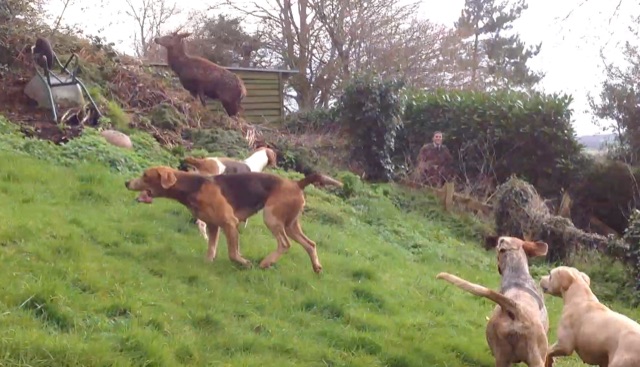 Stag at bay on a compost heap in a private garden adjacent to National Trust property on the Quantock Hills, March 2017. Photo © Hounds Off, with permission only
Stag at bay on a compost heap in a private garden adjacent to National Trust property on the Quantock Hills, March 2017. Photo © Hounds Off, with permission only
March 1st is when Spring Staghunting starts on the Quantock Hills and Exmoor. ‘Spring’ stags are the young adults, the stags with most energy and va-va-voom. These are a staghunters favourite quarry because they run hard, fast and long. For those who delight in chasing then killing fit and healthy Red deer then March and April are the most exciting months of the year.
Two years ago Teresa, a Quantock Hills resident, contacted Hounds Off and told us her story.
Teresa was in her kitchen. It was just after lunchtime. She could hear the Quantock Stag Hounds hunting really close and then saw out the window a hound by her garden pond. She grabbed her iPad to and went outside to take some film. The noise was suddenly deafening. There was a stag in her garden, up by the summerhouse. Other hounds were in the garden too and the stag moved towards the compost heap.
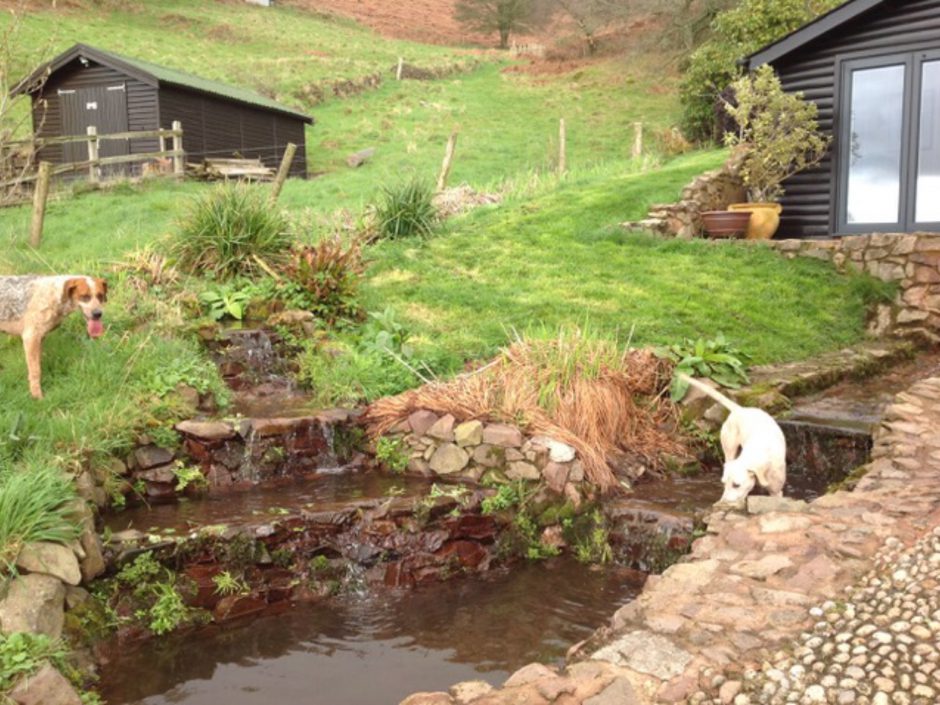
Hunting dogs from the Quantock Stag Hounds by Teresa’s garden pond. © Hounds Off, with permission
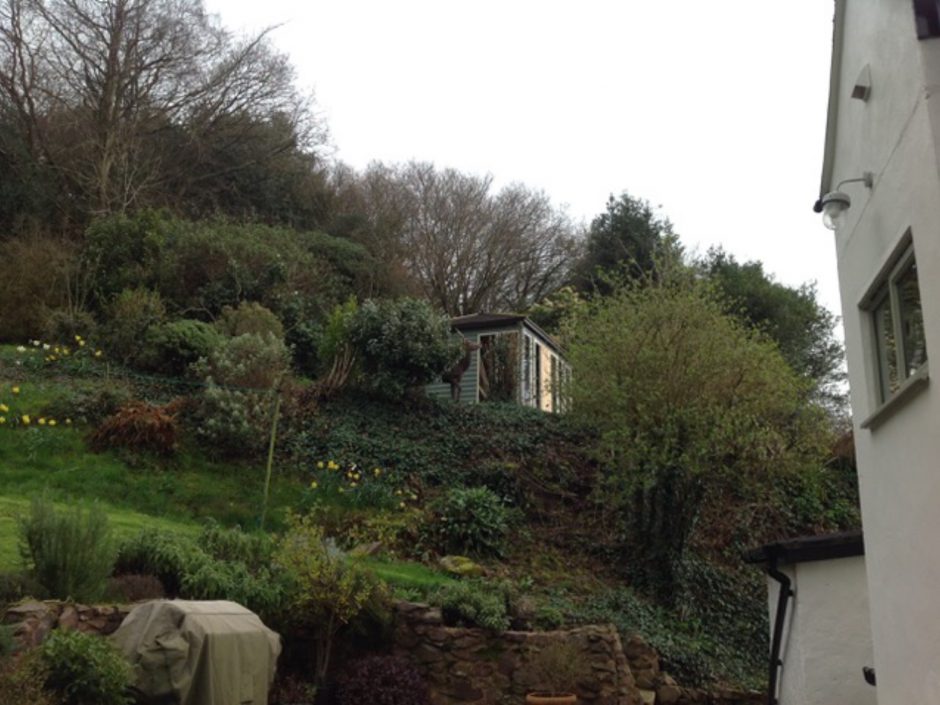
The hunted stag by the summerhouse © Hounds Off, with permission
A huntsman was just beyond the garden fence. He asked Teresa for permission to shoot the stag and she said, “No”. She asked the man his name and what he was doing. He said that she didn’t need to know. More hounds came in to the garden. Teresa reckoned there were about seven but they were hard to count because of so much movement.
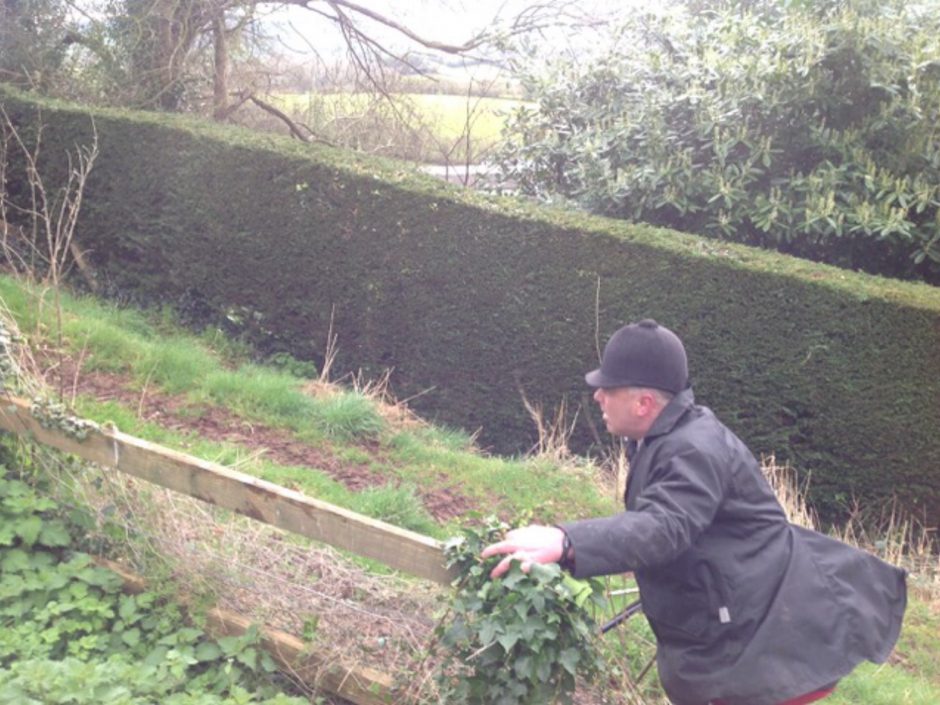
Teresa refused to let the Quantock Stag Hounds Huntsman shoot the stag in her garden. © Hounds Off, with permission
By now the stag had climbed on top of the compost heap. There were riders looking down from the hill up above and conversations could be heard between unseen hunters on walkie-talkies. Numerous vehicles were parked on her private entrance drive with people standing and watching.
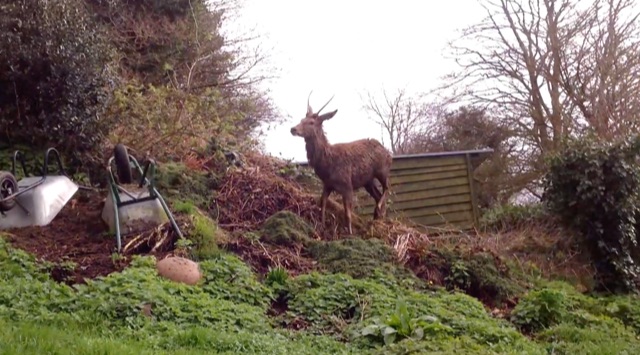
The hunted stag on the compost heap, using the height for protection. © Hounds Off, with permission
Suddenly there were four burly men at close quarters. The man who wanted to shoot the stag warned Teresa not to interfere in case the dogs attacked her. She was frightened because, as she told us afterwards, “I was outnumbered and could see that their blood was up.”
The dogs had chased the stag off the compost heap but he returned and was again at bay.

Stag at bay on a compost heap in a private garden adjacent to National Trust property on the Quantock Hills, March 2017. Photo © Hounds Off, with permission only
Teresa said, “The stag was surrounded by hounds and huntsmen and was clearly exhausted and petrified. I felt I needed to protect it. I felt strongly that it was not just right that I protect it, but it was my right to protect it. Not just because I don’t agree with hunting with dogs, but because it was in my garden and I should have been able to save it. My garden was its sanctuary.”
Again, she told the hunters to call their hounds off. One young, thick-set individual threatened to call the police because he said she was “harbouring a deer.” He also threatened to call the RSPCA, shouting that the stag was injured and had to be killed. But they did manhandle their dogs over the fence and remove themselves as well.
Another man who Teresa didn’t know or recognise appeared. He also refused to identify himself and joined the other hunters. They huddled together and then, right in front of Teresa, stormed into her garden, ran towards the stag and physically pushed it off the compost heap, over the fence and away towards private farmland. The men and their dogs, the riders and the people in cars all followed in different directions as fast as they could.
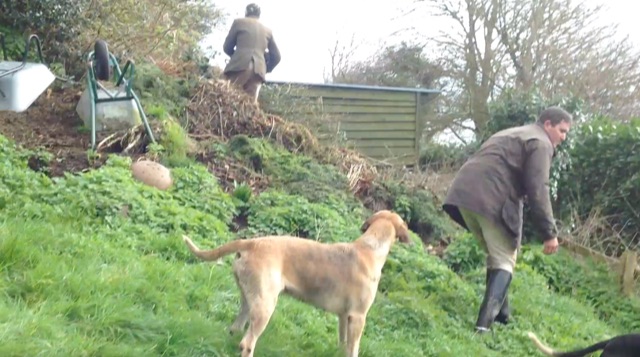
Quantock Stag Hounds men and dogs trespassed with menace to get the hunted stag running again. © Hounds Off, with permission
Teresa was totally shocked and shaken. She immediately called the police to report the incident.
A couple of hours later two huntspeople called at the house. Only one of them would give his name. He said that they were “trailhunting” with eleven hounds when unfortunately this young, injured stag jumped up in front and caused a distraction. They decided to kill it because, apparently, it was injured. Their excuses were not believed and apologies not accepted.
“A day later the Huntsman left a message to tell me the stag had been previously shot by a .22 rifle. I learnt later from the police it was in the chest,” Teresa recalled, “But this exposed them as liars. I was stood ten feet away from the stag for some time. There was no injury to the chest, old or new, but it was exhausted. I didn’t realize it then, but subsequently I found out that they have used this excuse before to exploit a loophole in the Hunting Act. I thought at the time that it was a really odd thing to say that they would call the police because ‘I was harbouring a sick deer’, but I later realized that they worked out which angle they were going to use to get out of this, hence why they didn’t care about me filming.”
Avon & Somerset Constabulary completely failed to take Teresa’s allegation of illegal hunting seriously and it appears that there was a deliberate block put on conducting even a cursory investigation. The Quantock Stag Hounds got away with it. But we helped call the police failures to account. Crucially, over a year later their own Professional Standards Department upheld six out of nine points of complaint.
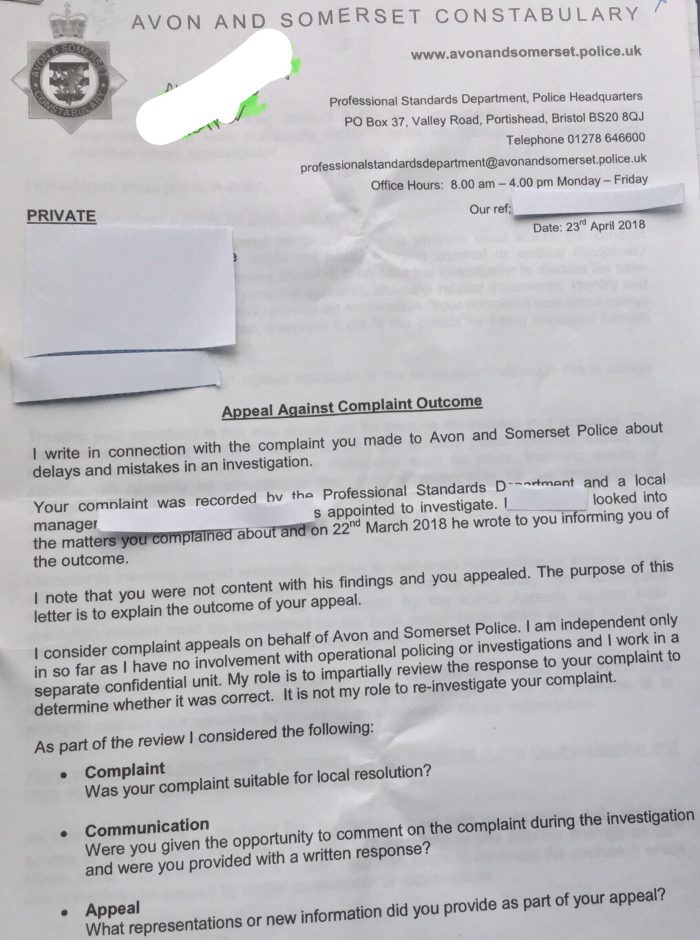
First of a seven page letter upholding six out of nine points of complaint made by Teresa. © Hounds Off
Teresa said, “When I reflect back with the knowledge I have gained over the last two years, I know that the Hunting Act has to change. Any reasonable person looking at the facts knows exactly what these hunts are up to. But the legal system is choosing to ignore the test of the reasonable person. As it stands today it is almost impossible to prove illegal hunting and get a conviction.”
Her immediate neighbours are the National Trust and she feels let down by them, too. Despite receiving all the evidence and her witness statement, and despite the fact that they themselves banned deer hunting with dogs on their land in 1997, the Quantock Stag Hounds frequently hunt across forbidden land. As recently as January 28th this year they held a fundraising meet and then hunted on National Trust land. Clearly this is unacceptable and we are in dialogue with the Trust to work out how to prevent future arrogant flouting.
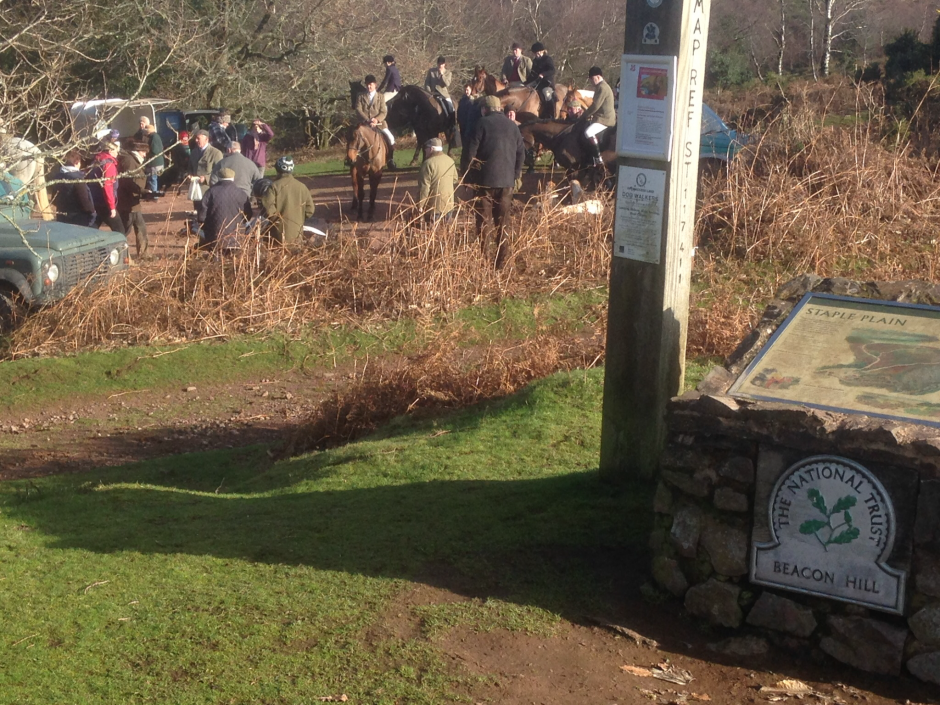
Members of the Quantock Stag Hounds meet on National Trust land at Beacon Hill Car Park, Staple Plain, West Quantoxhead, Somerset on Monday 28 January 2019. The National Trust banned all deer hunting with dogs from their properties in 1997. Photo © Hounds Off
Rural residents have turned to us in desperation and we answered their call. Our tactics are simple; in partnership with Somerset Wildlife Crime and individuals, groups and organisations who want to work with us, we’re shining a light on modern day staghunting. Please see the following links for more details:
- Your Membership (of the National Trust) And Voice Matters
- Staghunting On The Quantock Hills 08.10.18
- Press Release: Staghunting In Somerset, October 2018
- Nowhere To Hide
- Another Wretched day With The Quantock Stag Hounds
- Quantock Stag Hounds Meet Fundraise Hunt On National Trust Land 28.01.09
- How To Report Hunt Incidents To The National Trust
- Stag Hunters Break Convention To Ensure Valentines Day Sport
- Quantock Stag Hounds After Another One
Please consider . We couldn’t do what we do without you.
© Joe Hashman. Founder; Hounds Off
5th August 2018
The Fell Packs & #TrailHuntLies in Cumbria
As part of the wider National Dis-Trust campaign which started in Cumbria, we’re adding this to Hounds Off as a reference point for you to learn more about the fell packs, their abuse of wildlife, and why we’re calling for them to be permanently banned from National Trust land. All of the fell packs were either licensed to use Trust land for the 2017/18 season or given free reign to trespass and kill foxes. Here are a few of the ‘highlights’ of their history (click the links to learn more)…
- In November 2017, the Eskdale & Ennerdale Foxhounds were documented trespassing on National Trust land with terriermen, but subsequently received a licence anyway.
- On 06/09/2017, a representative of the fell packs told the BBC that numerous foxes are ‘accidentally’ killed each season.
- At the Peterborough Hunting Festival on 19/07/2017, huntsman for the Blencathra Foxhounds stated that his hounds can sometimes be unsupervised up to five miles away, meaning nobody knows what they are doing or what they might be killing.
- A supporter of the Melbreak Foxhounds attacked a member of Lancashire Hunt Saboteurs on 10/01/2017 who then needed hospital treatment. The hunt supporter was convicted of assault.
- The Melbreak Foxhounds supplied a fake certificate to the Trust dated 23/10/2016 to help gain a licence, and were granted further licences to use Trust land long after the lie was exposed.
- The Melbreak Foxhounds were filmed killing a fox on Trust land by Cumbria Hunt Watch on 05/11/2015.
- On 15/03/2014, the Ullswater Foxhounds were filmed killing a fox before attacking a hunt monitor, resulting in a conviction for assault.
- The Melbreak Foxhounds killed a fox on 09/03/2014 after chasing it across Trust land, resulting in a police investigation resulting in charges and the subsequent intervention of a member of House of Lords trying to defend the huntsman.
- The Blencathra Foxhounds were investigated for illegally hunting & abuse of hunt monitors in 2013.
- On 24/03/2012, walkers witnessed the Coniston Foxhounds killing a fox and police investigated claims that hunt supporters seriously attacked protestors.
- The News & Star reported on 09/01/2012 about hunting forum users allegedly admitting to illegal fox hunting whilst with the Blencathra Foxhounds.
- A supporter of the Coniston Foxhounds attacked a League Against Cruel Sports investigator on 09/03/2010, receiving a police caution.
- The terrierman for the Ullswater Foxhounds was convicted under the Hunting Act 2004 after digging out & beating a fox to death on 26/10/2009, after it had gone to ground. He continued to be employed by the Ullswater Foxhounds, which continued to be licensed by the National Trust.
- The Ullswater Foxhounds huntsman was in court on 17/09/2009 after a fox was killed by his hounds.
- Huntsman for the Coniston Foxhounds was convicted for criminal damage after smashing the windows of a hunt monitor vehicle on 19/02/2008.
- The Blencathra Foxhounds are believed to have killed a fox on National Trust land on 11/02/2006.
WHAT CAN YOU DO ABOUT THIS?
- Ask the Trust’s General Manager for Central & East Lakes firstly why the Melbreak have only been suspended, not banned, and secondly for him to stop offering licences to all fox hunts in Cumbria. His email is [email protected].
- If you live in Cumbria and want to volunteer for our campaign, please email us at [email protected] for packs of leaflets specific to Cumbria to deliver/hand out.
- Sign the Keeptheban petition to ban all hunting on National Trust land in England & Wales.
- Grass up the Cumbrian hunts if you see them by emailing Cumbria Hunt Watch on [email protected].
- Follow National Dis-Trust on Facebook and Twitter for updates.
© National Dis-Trust
28th July 2018
Are Hunters Spreading More Than #TrailHuntLies In Cheshire & Beyond?
 Are badgers really to blame for spreading bTB or is there another, much more dangerous, source? Photo courtesy of Cheshire Monitors
Are badgers really to blame for spreading bTB or is there another, much more dangerous, source? Photo courtesy of Cheshire Monitors
Cheshire Monitors write about hunting and it’s role in the spread of diseases, especially bovine tuberculosis (bTB):
The 2017/18 hunting season in Cheshire was interesting , to say the least. Yes, a number of Cheshire foxes sadly lost their lives to criminal interests but in many other ways it could not have gone better for us. We oversaw leaps forward in many areas as the nets were closing in on Cheshire’s three foxhunts….
- In response to Mike Amesbury MPs enquiries, Cheshire Police & Crime Commissioner announced a review of how foxhunting is policed in the county, as reported here by the Cheshire Chronicle.
- Cheshire’s Conservative MPs are abandoning their traditional support for foxhunting, mirroring the national stance of their party.
- Foxhunts are losing their land. Estates have recently revoked permission for access to their land in Cheshire.
Cheshire landowners would be wise to note this trend and get ahead of it by stopping hunts from entering their properties, especially those who have a stake in keeping disease at bay. Foxhounds have been recorded with bTB in a number of places, most notably within the Kimblewick Hunt where a large number of dogs were culled after picking up the disease in December 2016, and in Ireland where post-mortem results revealed bTB in foxhounds.
Biosecurity and foxhounds do not go well together. One report says they are at risk of a wide range of parasites and diseases including bTB when breaking up fox carcasses. Yes, foxes do carry bTB; just look at this research from France. Yes, foxhounds do break up foxes that they’ve caught; look at what Andrew German allowed to happen on Boxing Day 2017.
Conversely, the badger cull has found a very low rate of confirmed bTB in badgers across the country (a mere 4.87%) after testing 861 badger carcasses that were culled in High Risk Areas. A recent Freedom Of Information request to Nottingham University* pointed out that the tests can’t distinguish between ‘infected’ or ‘infectious’. It’d be charitable to describe the badger cull as a farce, and an expensive one at that (£831,093 in policing costs in Cheshire alone) …. and don’t the three Cheshire foxhunts employ people specifically to tamper with badger setts**? Not very biosecure, is it?
Foxhunters know about their role in the spread of bTB but hide it, as evidenced by the absolute stonewall at DEFRA that was erected after the Kimblewick Foxhounds outbreak. Did you know that the DEFRA Minister for Animal Welfare is a member of the Kimblewick and a former Master of one of the hunts which amalgamated to form the Kimblewick?
Foxhunters have known about the risk that hunting with hounds poses in the spread of bTB for decades. Just have a read of this quote from ‘To Hunt A Fox’ (1937) by foxhunter David Brock, page 187;
“There is in this country a great move on foot for the establishment of more and more Tuberculin Tested herds. To establish such a herd is an expensive and troublesome affair and, once he has established it, the farmer is not going to risk incurring infection from outside. It is at present believed that this infection can be carried on the boots of human beings and the feet of animals. What more likely than that it will be carried from an infected farm to a pure one by horses and hounds?”
We’ll leave these thoughts with you. If you’re a landowner in Cheshire (or anywhere) who wants to stop hunting on your land then please contact Hounds Off for specialist help, support and advice.
* Hat-tip to Cheshire Wounded Badger Patrol for this
** No, they are not there to mend fences
© Cheshire Monitors
1st April 2018
But….They Say They Only Hunt Trails
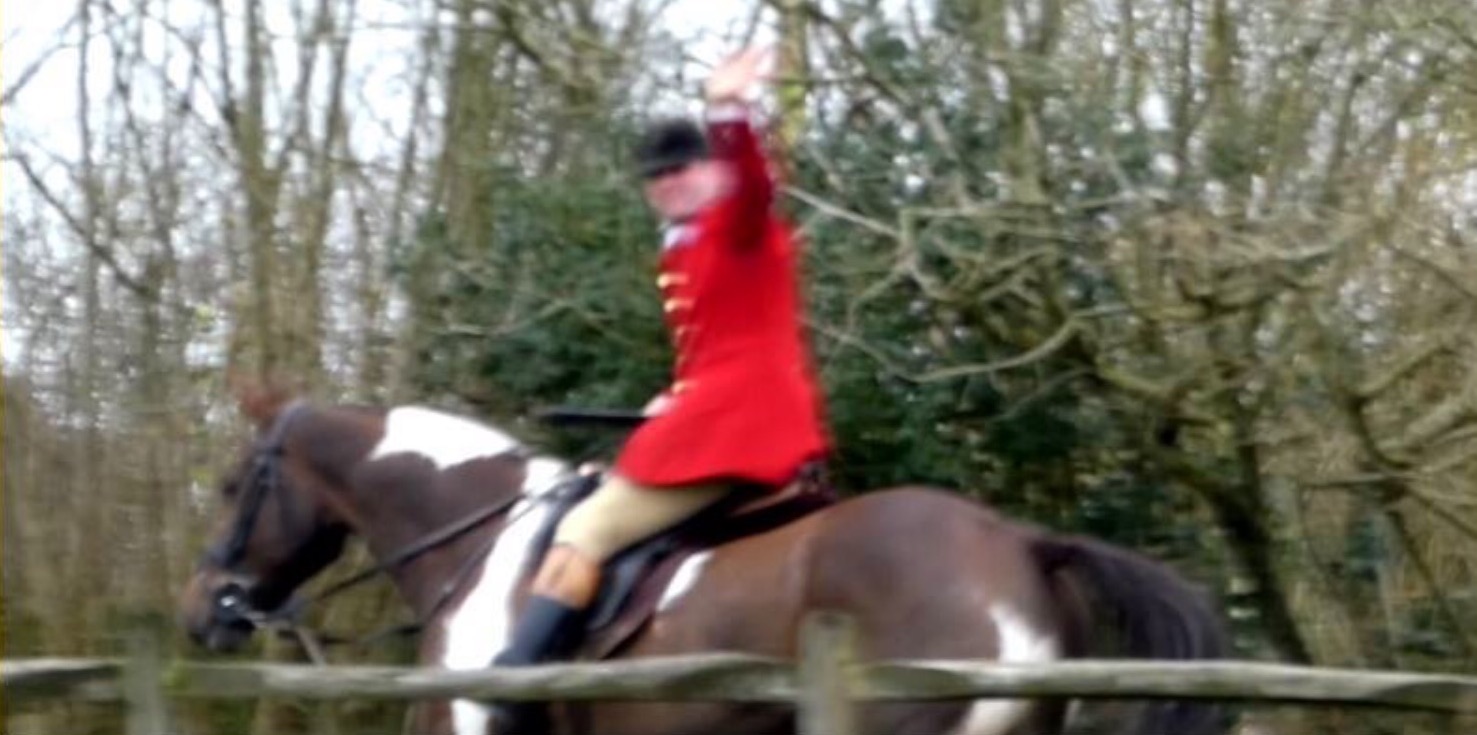 Huntsman of the Eggesford Hounds waves sarcastically at landowners who want to keep him and his hounds off Wheatland Farm in Devon (who took this pic on 30.03.18).
Huntsman of the Eggesford Hounds waves sarcastically at landowners who want to keep him and his hounds off Wheatland Farm in Devon (who took this pic on 30.03.18).
Hunts do not always respect landowner wishes. Often people ask the local hunt to keep staff, followers and hounds off their property but then it happens - again. You need patience, stamina and strong support to stand up for yourself.
Sadly hunt trespass is all too common still. Hounds Off currently supports loads of people who are bemused at the attitude and arrogance of repeat offenders. In the instance below we are also asking ourselves, “But if they chase man-laid trails with dogs that are under control, like they say they do, then how come the Eggesford hounds were running all over forbidden land for the second time this year?”
Eggesford Hunt on Popehouse Moor Again: Wheatland Farm, Devon 30 March 2018
Are you troubled by the hunt? Contact Hounds Off
© Joe Hashman
26th February 2018
Trail Hunting - A Nationwide Criminal Conspiracy
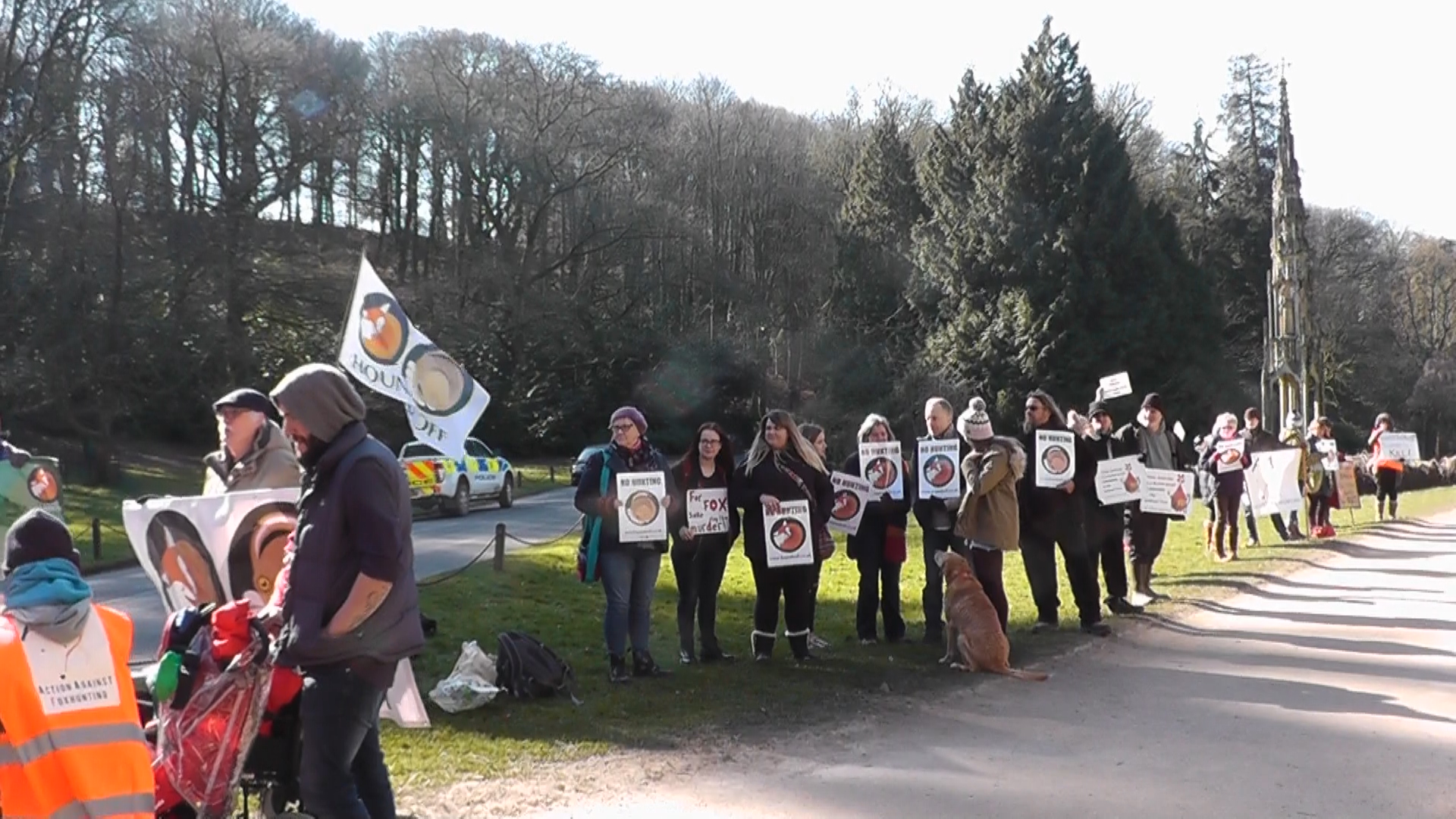 Campaigners continue to expose #TrailHuntLies & lobby the National Trust to stop issuing licences to kill fox, hare, deer & mink on their land for so-called 'sport'. Here, at Stourhead in Wiltshire on 25 Feb 2018 as part of a day of similar protests at NT sites around England, co-ordinated by the National Dis-Trust. Pic: Hounds Off
Campaigners continue to expose #TrailHuntLies & lobby the National Trust to stop issuing licences to kill fox, hare, deer & mink on their land for so-called 'sport'. Here, at Stourhead in Wiltshire on 25 Feb 2018 as part of a day of similar protests at NT sites around England, co-ordinated by the National Dis-Trust. Pic: Hounds Off
Trail hunting is a myth, a ruse invented by the hunting community to enable them to continue abusing wild mammals with dogs for sport.
Trail hunting was invented on the day the Hunting Act (2004) came in to force. It has been used as a false alibi to cynically subvert the law ever since. There is no trail hunting governing body, there are no written rules and regulations to which participants must abide. How to conduct a so-called trail hunt is left up to each individual hunt to decide.
Trail hunting is billed by the Countryside Alliance and their allies as a temporary activity which sustains the infrastructure of hunting until such time as the law banning bloodsports is repealed. One of the main tenets of this charade is the principle that the scent which is laid for hounds to follow is based on their traditional quarry. They say that this will enable them to switch back to fox, hare, deer and mink hunting at the drop of a hat because their hounds won’t need retraining. We say that this pretence enables them to “accidentally on purpose” harrass and kill live animals. Nobody, not even the National Trust, is denying that “accidents” happen.
In 2017 the National Trust introduced some changes in the rules they claim hunts must obey in return for a licence to trail hunt on NT land. The first of these is banning the use of animal-based scents as a trail for hounds to follow.
“This will reduce the risk of foxes or other wild animals being accidentally chased,” the NT tells us. Alas, it’s a nonsense.
Hunts continue to train their hounds to hunt the scent of their traditional quarry, not something else. You cannot have a situation where a hunt goes after a fox-based scent on private land on Monday, then an artificial scent on NT land on Wednesday. Hunting a pack of hounds doesn’t work like that. Training a them to be steady and reliable on one thing takes time and effort. And who’s checking anyway? Not the NT. They’re happy to let hunts self-regulate.
We believe that everybody who follows so-called trail hunts, save newcomers, children and the terminally naive, knows that trail hunting doesn’t really exist. Sure, somebody might trot around with a duster on the end of a whip as lip service to a ‘trail’ for the benefit of show, or if the press or cameras are present. But away from outsiders, out of public gaze, hunting wild mammals with dogs for sport continues much as it did in the last century. There is, we suggest, a nationwide criminal conspiracy to facilitate this animal abuse. It’s tragic that the National Trust Ruling Council chooses to collude.
© Joe Hashman
19th February 2018
National Trust: “Talk To The Hand……..”
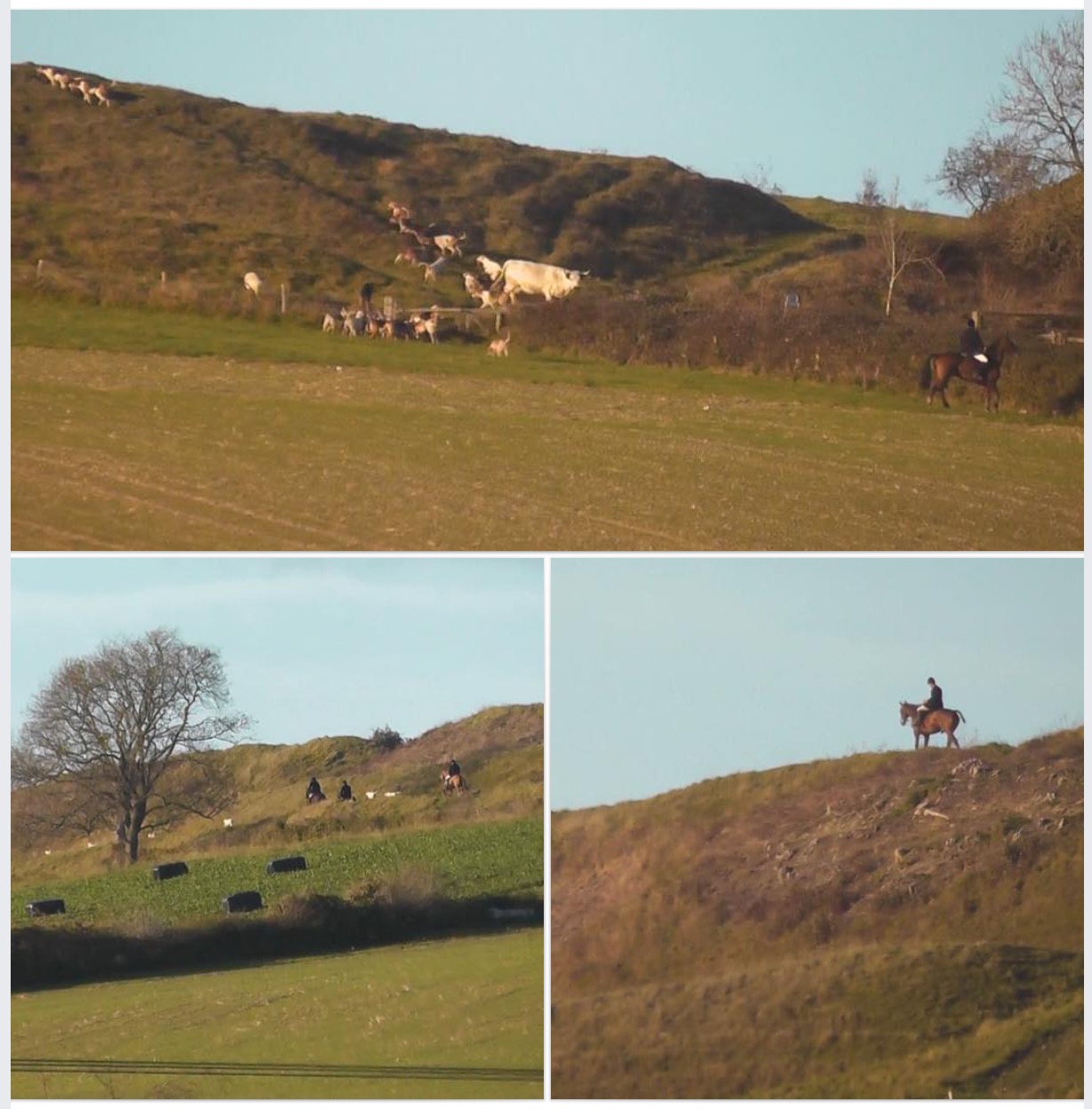 The Portman Hunt all over Hod Hill in North Dorset on 6 November 2017. Hod is owned by the National Trust. Hunting is only permitted under licence. No licence existed. Photos: Hounds Off
The Portman Hunt all over Hod Hill in North Dorset on 6 November 2017. Hod is owned by the National Trust. Hunting is only permitted under licence. No licence existed. Photos: Hounds Off
Hounds Off Founder, Joe Hashman, reports:
It’s no wonder that so many people have lost faith in the National Trust. The vote rigging debacle at their 2017 AGM and their attitude to what we call #TrailHuntLies has been documented on these blog pages and elsewhere. It’s not something which just became an issue recently. The campaign to stop hunting on National Trust land has been going on for decades and is unlikely to disappear any time soon. I believe that to influence change within an institution like the NT, albeit a charitable one, you need a voice and a vote. That’s why I’m a Member. It’s just a shame that Members who highlight broken promises, breaches of licences and/or the law are currently being stonewalled with cut-and-paste platitudes.
On 6 November 2017 the Portman Hunt went onto Hod Hill, an Iron Age hill fort in North Dorset which is owned by the National Trust. I was there, turned my video camera on and recorded what happened. Hunt staff, followers and hounds were on Hod for 33 minutes between 3.16 and 3.49pm. There is a public bridleway across the site which anyone is free to use unfettered, but the Portman Hunt was not on this. They were all over the place. I understood the Portman was only allowed onto National Trust land if granted a licence and that, on 6 Nov ‘17, no such licence existed. That evening I contacted the landowners.
My initial email simply asked, “Please could you tell me if the Portman Hunt has a licence from the National Trust to do so-called trail hunting on Hod Hill, Stourpaine, North Dorset?”
There was no response so I resent it five days later. Oliver Silvester of the National Trust Supporter Services Centre answered by return. He redirected me to Amy Middleton at National Trust West Dorset. She’s the Estate Manager and Hod is on her patch.
Amy wrote back very candidly, “I can confirm that the Portman Hunt does not have a trail hunting licence for Hod Hill.”
I thanked Amy for confirming that this was an unlicensed activity and therefore not permitted by the National Trust. I informed her that I had GPS-verified evidence on film.
My email closed with this question, “In view of the fact that they were on National Trust land without a licence I would, as a Member, like the National Trust to take this matter further. Please could you advise me what action the National Trust will be taking and what I can do to assist the process?”
Three days later came the reply.
“The matter has been raised directly with the Master of the hunt,” said Amy in her email, plus, “We take any reports of hunts acting illegally or outside the terms of any licence very seriously.” I wondered how seriously they took hunting on their land with no licence at all!
Five days later I sent another email just to confirm that I was not reporting illegal hunting but specifically, “unlicensed trail hunting”. I wanted to know what was being done to ensure that it didn’t happen again.
Next day Amy Middleton, National Trust Estate Manager for South Somerset, West Dorset & Knightshayes, replied, “We are treating any report of trespass on a case by case basis and endeavouring to establish the facts. At this stage I am unable to comment any further.”
A day later I opened an email from Oliver Silvester of the National Trust Supporter Services Centre. Oliver wrote, “We have raised your enquiry with our Specialist Team who should respond in due course.”
They did. On 24 November 2017 Sophie Novelli dropped me an email. Apparently she works on the Specialist Team who were looking into the details of my “query”. Apparently it had been forwarded to the Estate Manager of their Regional Office, a person called Amy Middleton. Sophie ended her missive, “I am sorry that we cannot be of any further help as we specialise in membership and donations.”
And that’s the last I’ve heard of it.
There has been a related development….
The Portman Hunt Huntsman appeared at Poole Magistrates Court on the 12 and 13 February charged under Section 1 of the Hunting Act (Hunting a Wild Mammal with Dogs) in March 2017. What came out under cross examination was that the alleged offence occurred on the National Trust-owned Kingston Lacy Estate. The case was not concluded and the District Judge set a further date of 14 March 2018, at Poole, to deliver his verdict.
Of course, in law a person is innocent until proven guilty. We make no assertions one way or the other at this stage. But, depending on the outcome of this case, it will be interesting to see how the National Trust responds as a consequence.
To be continued….
© Joe Hashman
You can join a peaceful protest at a National Trust property near you this Sunday, 25th February. See this link to the National Dis-Trust for details.
.
23rd January 2018
Providing Support For Those In Pain & Distress
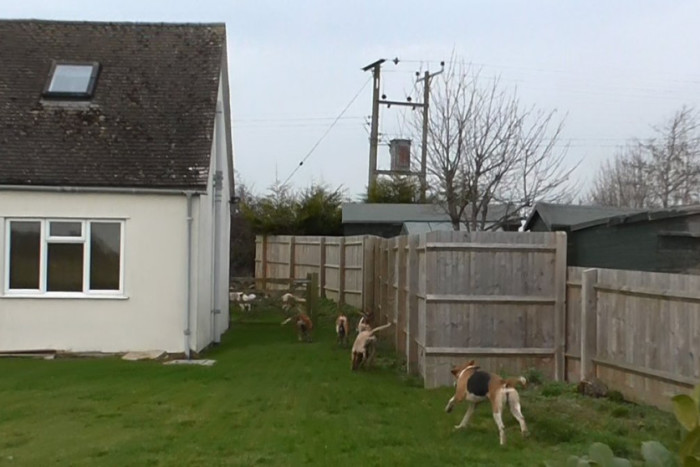 Hounds from the Warwickshire Hunt running out of control in Oxhill near Banbury. Pic credit: West Midlands Hunt Saboteurs
Hounds from the Warwickshire Hunt running out of control in Oxhill near Banbury. Pic credit: West Midlands Hunt Saboteurs
Last week we met a woman who had a foxhunt invade her property. She was still raw from the experience and visibly upset when telling us about it.
The local hunt was in the area and had let their hounds run loose on the scent of a fox. The fox ran into private woodlands with the hounds in hot pursuit. A herd of deer in the woods distracted the hounds and they split up to chase the deer in all directions, then cats, a dog and a goat. The woman and her friends were minding their own business just getting on with their day. Then this bedlam descended, literally, upon them. There weren’t enough broom handles or people to cope and anyway, the hounds were only interested in hunting.
This was no fleeting stampede. It took over an hour for the Huntsman to gather and remove his dogs. By then the police had turned up and were also helping. Two weeks later and six cats are still missing, presumed dead. The others are nervous, shy, frightened. It will take time and tlc to recover their confidence.
The woman was traumatised. She shook as she talked. Her eyes welled up when she described how the peace and tranquillity of her sanctuary exploded with animals running left, right and centre when about twenty-five foxhounds in full cry descended the valley with no warning. She expressed surprise at how big the dogs were and shock at seeing a fox flash past at great pace, running for its life. We explained that, actually, hunts across the land are breaking the law. All the hunters have to do is claim it was an “accident” and they get away with it. She now knows first hand the reality of #TrailHuntLies.
Hunt trespass can have a profound effect on people. It traps some in their homes, fearful to go out on certain days of the week in autumn and winter because they never know if the hunt is going to come crashing through their place. That is no way to live.
Imagine stepping out of your back door and being almost knocked over by rampaging hounds, then having someone sat high up on a horse shouting down at you and gesturing to open your gate so they can come in and fetch them. This actually happened in Dorset and now we keep in close contact with the woman and local police. She is clear and so are we - there must never be a repeat of this.
A young mother who had foxhounds come into her kitchen told her local newspaper, “I am shaken and beyond furious. I can’t bear to even speak to the hunt master who obviously thinks that my home, a haven for my children, is fair hunting ground for their hounds to come and go freely with complete disregard for the safety of my children.”
We watched with interest the evidence of terriermen following a hunt in Devon digging out a fox which hounds had run to ground on Saturday. To most right-minded people it’s an open and shut case but we’ve noted the terriermen’s excuse that they did not intend to kill the fox and were merely rescuing their dog. Without doubt they’ll lay that on as thick as possible and trust in the police to do less than a proper job. It grieves us to write that Devon & Cornwall Police have form. Despite this we’ve helped a number of disgruntled locals who have reported trespass and intimidation by the self-same hunt this last fortnight. We always advise involving the police at the outset, firstly by reporting anything which makes you feel concerned or unsafe and secondly, by cc-ing them in to all correspondence. We always live in hope to be pleasantly surprised.
We’ve been having a conversation with woodland owners in Somerset since December. They’re fed up to the back teeth of having the local hunt ripping through their land and terrorising its human and non-human inhabitants. We’ve arranged to meet later this week. So it was wonderful to receive an email from our contact this morning with details of three neighbouring farms who want to keep hounds off their vast acreages too.
January is always a busy month. We believe this is because it’s the fox mating season. Dog foxes are on the move in search of love. Their wanderings frequently take them far away from of their familiar, home patches. A hunted fox will instinctively bolt down a hole but hunts block all underground refuges and so the fox is forced, against its natural instincts, to keep running. Hunts deny this, of course, but we know the truth.
The above is just a snapshot of what we have going on right now. If you’re affected by hunt trespass or know someone who is then please, contact us. Hounds Off will support you. You are not alone.
You can support our work by or buying some Hounds Off merch. Please consider it. We are all volunteers and cannot survive on goodwill and fresh air alone!
© Joe Hashman
28th May 2017
The Magic Of Hares
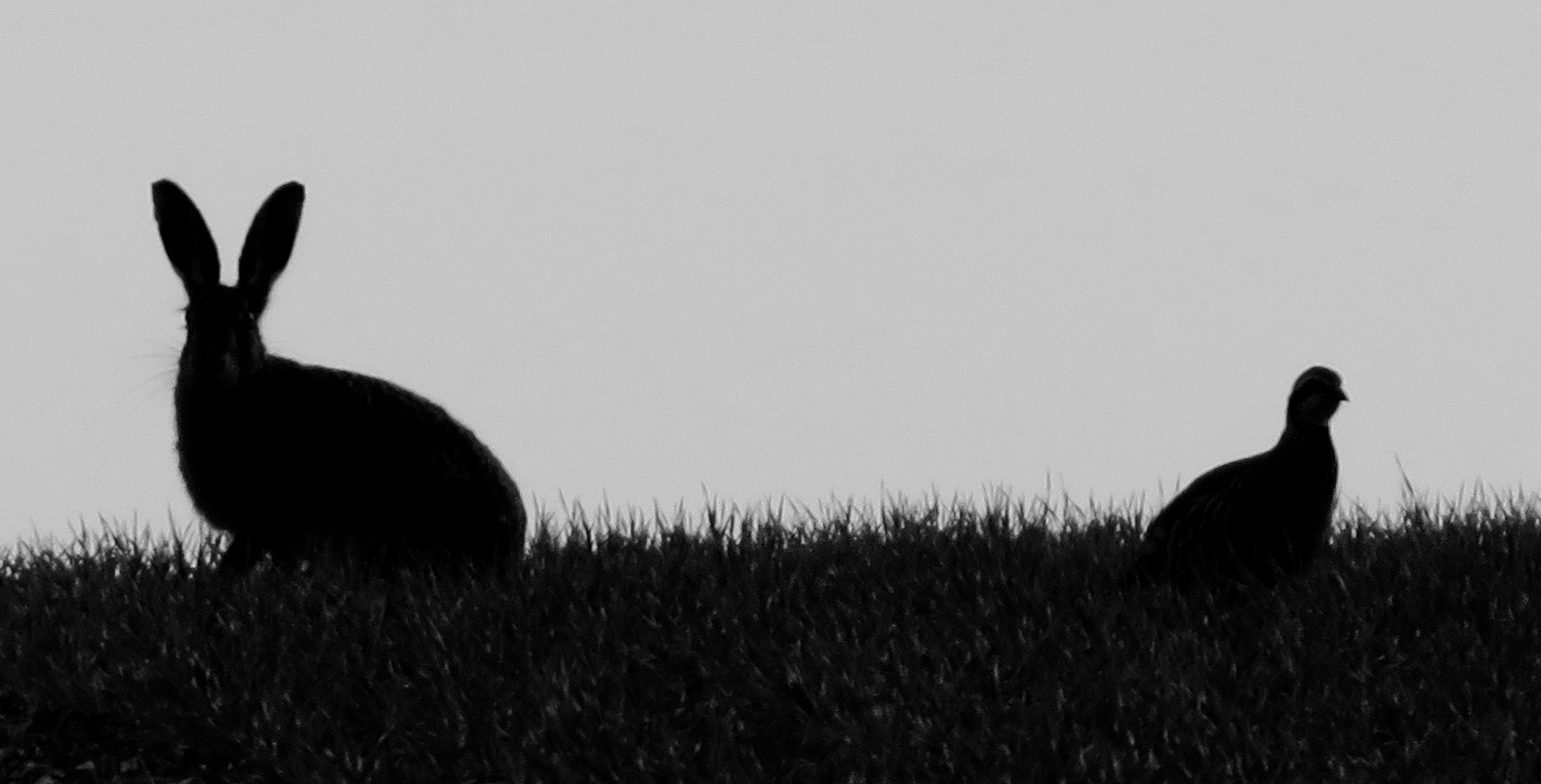 Hounds Off is grateful to Brigit Strawbridge for her permission to use this 2017 photograph.
Hounds Off is grateful to Brigit Strawbridge for her permission to use this 2017 photograph.
The Hare Preservation Trust invited Hounds Off Founder, Joe Hashman, to write the The Magic Of Hares to mark the occasion of their 2017 Annual General Meeting & HareFest which took place at Aldeburgh in Suffolk on Saturday 28 May:
THE MAGIC OF HARES
It’s hard to know how to properly explain what I think about hares.
It’s not enough to say, “They’re amazing creatures, magical, beautiful, I love ’em, look at their ears, those legs, you wanna see them moving, they’ve got wild eyes.” Words don’t adequately convey my feelings towards hares, or how they pull on my heart strings and stir emotions which always feel deep.
I do love hares. I love hares that I see doing their thing in passing fields beyond the windows of a car, I love hunted hares which I worry about and desperately want to escape, and I love all the hares in between.
My first encounter with a live hare was when I was in my early teens, while travelling on a West Oxfordshire backroad to play an evening tennis match. She was large and upright, poised on the tarmac ahead, then gangly but strong, powerful, poetic as she ran.
It was a straight and open stretch of single track lane so we were treated to an extended view. My Mother slowed to an appropriate speed so we could safely but closely see this almost unbelievable creature. Then, in a bound, she was gone, jinking right-handed into the luxuriant verge.
This hare made quite an impression. In that moment her species lept off the butchers shop meat hooks in Oxford’s Covered Market, out from pages of natural history books in the school library, and into my life.
I was upset to learn that hare hunting with dogs was considered to be good sport by people who did it to keep themselves entertained.
AN INTRODUCTION TO HARE HUNTING
My next hare encounter was with the Oxford Polytechnic Hunt Saboteurs Association. They were an effective and experienced bunch. I was a 14-year old local kid but the student hunt sabs took me under their wing in almost parental fashion. They taught me well.
It was early January 1983. We parked in the middle of nowhere and walked cross-country to a remote Buckinghamshire railway hamlet called Verney Junction to catch the Old Berkeley Beagles by surprise. Elderly folk leaning on sticks and gazing into fields gave us clues where the sharp end of the hunt was, and we caught up.
Strange individuals were in charge, running around, blowing a bugle and cracking whips, wearing breeches and riding hats. They controlled a pack of beagles and quartered the sticky plough fields in search of hares to chase. We shadowed them as best we could, using footpaths and avoiding the supporters who were unfriendly and aggressive.
Sometimes a hare would jump up right in front and sprint away. The dogs erupted into mad, unified barking and set off in hot pursuit, using their noses not eyes to follow an invisible scent. The hunters in their breeches, riding hats and green jackets legged after them, and when this happened I learned what to do.
Sooner or later the beagles would ‘check’. This meant they would lose the hares scent and have to refind it. Maybe the hare had doubled back on herself then run off at a sharp angle, or done a huge leap to the side to make it seem like she had just disappeared, or any number of other tricks her species can employ to throw hounds off their backs.
A check allows the Huntsman to catch up and assist his pack. We tried to disrupt the hunt by shouting at the beagles and clapping our hands to make them lift their heads. When their noses were up they were not actively hunting.
One sab in our group had a hunting horn. If we couldn’t get near then this was blown to imitate the Huntsman and confuse the beagles. I could see it worked. They were excited and could be encouraged to come towards us which was perfect if we knew the hare had gone in another direction.
Whenever we saw the hare running we sprayed citronella oil to cover her scent. We sprayed hedges and field edges, wherever we thought a hunted hare might pass or have passed. All the time we were watching, looking for the movement of a small brown hare against a background of naked, thorny hedges and rich, deep plough, trying to keep one step ahead of the hunters and follow in her footsteps, not theirs.
Next week we were on a hillside, sabbing the Old Berkeley again. Beagles were nose-to-the-ground ahead of the Huntsman, searching after a check. We were well placed, discreetly in front and to the side.
The hunted hare broke cover and we dropped to our knees to appear small and unthreatening. The hare ran without a break of stride right passed us, so close you could hear the patter of her feet on the short turf and see into her big, bright, staring eyes.
We sprang into action, spraying citronella, shouting, clapping our hands to distract the excited beagles and get them to raise their heads. We didn’t stop the hunt completely but we did continually delay and disrupt until it got too dark to keep going.
Hares are also hunted on foot with basset hounds. Bassets are very wilful creatures and can appear almost comical in the hunting field. But don’t be fooled. A basset pack which is in the mood to hunt and kill a hare is relentless and deliberately cruel. Whereas the beagler hopes for an ideal hunt of 90 minutes from find to kill, with bassets the duration can be much longer. Hares are evolved to survive with short sharp sprints, not endurance running.
Hunting hares with hounds by scent demands patience, concentration and skill. Sabs developed and employed tactics designed to test all of these to the limit.
The most effective tactic is to take the pack completely. Beagles especially will happily run after nothing at all. They can be encouraged off the line of a hare when they check with appropriate horn and voice calls. Then it’s important to run as fast and far as possible before the hunters can get them back.
Beagles and Bassets are vulnerable to disruption and by 1986 had gone underground. The Shooting Times ceased advertising hunt meets full stop, and the Horse & Hound ‘Hunting Appointments’ section had reduced to a hard core of mounted fox and stag packs.
Luckily, in September 1986 I was given access to an archive pile of Horse & Hound magazines and noted five seasons worth of Old Berkeley Beagles meets.
There were clear and reliable patterns. October meets were nearly identical and then quite predictable for the rest of the season. One or two, like Monks House Farm outside Evenley near Brackley in Northamptonshire, took a bit of working out, but we got it. Lots of meets were held at pubs so a well-thumbed phone book and ringing around with a fake posh accent confirmed most fixtures with uncanny accuracy.
One Wednesday from Botolph Claydon the beagles picked up the line of their quarry early. The hare they were onto chose not to sit and sprint but kept on the move slower and steadier, way out ahead of hunting beagles. Elderly followers would indicate that they had seen her by raising a stick or holding aloft their caps. These signals informed the Huntsman where and when to gently guide his hounds.
It just so happened that the hunted hare and I crossed paths repeatedly during the early afternoon. Whenever this happened I’d put down some citronella and hope to buy her some time. But conditions that day were unhelpful and her scent was strong. Eventually the hunted hare ran towards me, then turned along a hedgeline with the pack on full cry just seconds behind.
The only way to stop them this time was to break cover. I shouted, sprayed and caused as much distraction as possible. Initially it worked. Beagles burst through the other side then lost momentum, lifted their heads and spread. But there were too many and it was too hot for me to handle. I was assaulted by the Field Master but wriggled free and had no choice but to get away as fast as possible to avoid a beating from him and others.
My moped was parked by the church. It stepped-through first time and I rode home at a top speed of 30 miles an hour. It was a traumatic experience which I recounted to my Mum. She listened and said only that, “Hares can sense when you are there and trying to do good.”
In 1986 I was an estate worker for the Berkshire Buckinghamshire & Oxfordshire Naturalists Trust, doing practical woodland and other habitat management. I was an excellent worker; punctual, reliable and keen.
It was quite a shock when the Old Berkeley Beagles Huntsman walked in to the office on the evening of our Christmas party. Turned out he was the North Buckinghamshire Regional Chairman. Early in the New Year I arrived five minutes late for work and was sacked on the spot.
RADLEY COLLEGE BEAGLES
A few public schools keep their own pack of beagles and at these institutions, hare hunting is on the curriculum. One, the Radley College, used to access many of its meets by driving right passed the top of our road. Even younger kids from an Oxford prep school called The Dragon were bussed out twice a week to join them in the countryside and learn how to kill for fun.
In late 1989 at a place called Appleford they hunted a hare into private gardens. Locals were outraged. A petition was launched asking the Radley College Beagles to stop meeting at Appleford and 80% of villagers signed it. The Bursar of Radley College publicly promised “to do everything possible to avoid future problems”, but he wouldn’t commit to dropping the meet at Church Farm.
Two sets of severed hares ears were sent to my parents house through the post so clearly our campaigns were touching a nerve and sabbing on the day saved lives. The importance of non violent direct action cannot be underestimated. But looking back it’s worth considering, with these schoolboys especially, did we win hearts and minds or just make them more stubborn and entrenched?
HARE MEMORIAL DAY
On March 6th 1989 a vigil was held at the Martyrs Memorial in Oxford to remember hares killed by hounds. Over 40 people attended, listened to speakers and held a silence. Afterwards some of us went on to sab the Christchurch & Farley Hill Beagles. This is the Oxford University hunt and, as with the school packs, introduces many outsiders to so-called “fieldsports” and the lifestyle that goes with it.
Students who wanted to go beagling met at Oriel Square in one of the colleges, then got a lift. On Hare Memorial Day we had someone at Oriel Square, working undercover. She called in from a phone box to tell us the meet was at East Hanney. No hares were killed but the police were heavy handed.
I was arrested and charged with possessing an offensive weapon - a hunting whip - and threatening behaviour. In May, Wantage Magistrates Court ruled that the case should be discontinued but in early July I received a summons for non payment of outstanding costs. They were holding me liable for £156 because, technically, the case was never formally dropped. I went straight to the press and a week later Wantage Magistrates Court ruled that it was unfair to expect me to pay costs for a case which never got heard.
On another occasion out with this lot, we were set apon by a gang of local foxhunt thugs. Horns and sprays were stolen, we were assaulted, bloodied and bruised.
Be in no doubt that folk who enjoy killing a creature as timid and harmless as the hare will use any means possible, fair foul or violent, to quieten dissenters.
THE WATERLOO CUP
The Waterloo Cup was a three day festival of hare coursing. In coursing, hares are used as a live lure to test the speed and agility of two fast-running dogs like greyhounds. The Waterloo Cup was a sixty-four dog stake which, by process of elimination, whittled down to a grand final and eventual winner. There was prize money, prestige and the bookies loved it.
The hare coursing season ran from September to March. During that time lots of clubs around the country would hold smaller events of one day, sometimes two. The Waterloo Cup was the peak of the season, bringing together all winners and qualifiers. In its heydays of the late 1800s, crowds of eighty thousand would flock to watch.
The National Coursing Club was the governing body for this sport. They advised spectators not to identify with the hare because doing so might spoil their enjoyment. You have to wonder what kind of sub-human gets their kicks from watching hares running for their lives right before their eyes, sometimes even in and around their feet, twisting and turning, often being caught, frequently being savaged in the jaws of both dogs, almost always having to be killed by a coursing official called a “picker up” who would put the pitiful creature out of this totally unnecessary and extended misery by pulling its neck.
In 1985 the Hunt Saboteurs Association organised its annual disruption of the Waterloo Cup. Previously, terrible violence had been dished out to sabs by coursing supporters so on Day One protesters marched the lanes as close to the coursing fields as possible, always with a heavy police escort.
Day Two was different. Sabs were up before dawn, driving to a secluded spot just beyond the northern fringes of Liverpool in an assortment of battered transit vans and old cars.
Ahead was the River Alt. The location had been identified as a suitable fording place to reach the fields opposite. Later that morning hares would be corralled there so they could be released, one by one, into an arena in front of the dogs and jeering, rowdy crowds.
Gamekeepers encouraged unnaturally high numbers of hares around the West Lancashire village of Great Altcar specifically for coursing purposes. Hares were also imported from other places before this and other big coursing events. It was quite likely that some had recently arrived from the Six Mile Bottom Estate in Cambridgeshire. Sixty-three hares were needed to run the Waterloo Cup itself, and many more to complete the Plate and Purse competitions which ran concurrently. The last thing that coursing officials wanted was a shortage of quarry.
Sabs waded across the river and were organised into long lines which stretched across the fields. I was in one of these lines. There were sabs to both sides at close but regular intervals. Our tactic was to move in unison and shepherd hares out of the danger zone. As we walked, hares were jumping up all over the place. Some tried to dodge between the gaps. We had to create a wall of noise to turn them back.
Soon the police arrived. They emerged from the mist mob-handed and all wearing regulation black wellies. I was grabbed and frogmarched to a waiting mobile police cell which soon filled up. Sixteen of us were tried and found guilty at Ormskirk Magistrates Court of causing Criminal Damage to a field of cabbages. We were bound over to keep the peace. Prosecution witnesses included cops, coursers and their lackeys. They all lied through their teeth so we appealed. I was a minor at the time of the arrests. The Judge at Preston Crown Court granted my appeal alone, on the grounds of being led astray by the grown-ups.
The Waterloo Cup ran for another twenty years but 2005 was to be the last. For all it’s faults, the Hunting Act was unequivocal in making hare coursing illegal.
PALMER MILBURN BEAGLES
Beaglers and their like circumvented the Hunting Act by inventing the false alibi of ‘trail hunting’. They claimed to lay a scent themselves then set their dogs on to that. And because rabbits are not protected by the Hunting Act, they would pretend to be hunting these animals whenever it suited.
Rabbits bolt for a hole at the first sign of danger and are never more than a short dash away. I remember reading one post-ban feature article in the Horse & Hound about a beagle pack in Somerset, and the impossible tale of a “rabbit” that led hunters and their hounds a long and merry circular dance around the cider orchards of West Bradley.
The Palmer Milburn Beagles used trail hunting as a cover for illegal hare hunting in Berkshire and Wiltshire. One of their favourite hunting grounds was Salisbury Plain, a huge area used by the Army for training exercises.
Salisbury Plain mostly comprises vast tracts of open, uncultivated grassland with scattered woods which stretch as far as the eye can see. There are few metalled roads. It can be a desolate and wild place.
In this habitat hares thrive. They are big, wily creatures who enjoy sheltering amid the dips and folds of rough vegetation and dining on an unrivalled selection of naturally occurring seasonal herbs and grasses. For hunters, these hares are prime quarry and for that minority of people who are thrilled by such things, Salisbury Plain is an ideal place for pitting a pack of beagles against hares which are in the peak of physical condition.
For a couple of months during Winter 2006/07 I followed the Palmer Milburn Beagles with my colleague, Shely Bryan. Shely and I worked for the International Fund for Animal Welfare. Our job was to gather evidence of Hunting Act offences for prosecutions.
We had a source for meets on Salisbury Plain so decided to take a look. First time out we pretended to be four-wheel drive enthusiasts who enjoyed muddy rides along the numerous tank tracks and green lanes. Then we pretended to be interested in watching the beagling but were too lazy to get out and walk. Instead we followed in our vehicle. Nobody objected so we spent many days tagging along.
Shely and I used the cover of being in a vehicle to discreetly gather loads of evidence. Our films showed that people were using a pack of beagles to find, chase and kill hares on Ministry of Defense land just as they had before hare hunting was banned. We showed that this was being done repeatedly and deliberately. We got footage of hares being chased by beagles, hunt staff and supporters in that order. We identified the people involved and evidenced other behaviour that was specific to beagling.
One piece of footage showed a hunted hare running below a supporter, then changing direction. A minute later the beagles came along the same line as the hare. Where the hare turned, they checked. The supporter who had seen the hare running below them raised his cap on a stick to show the Huntsman where she had gone and he, in response, got his hounds on the line again.
On one occasion we filmed the beagle pack in full cry some way off. They hunted fast and hard then stopped and sniffed about. We could see the Huntsman nearby in the same area of long grass. Suddenly the beagles all converged really quickly in one place and the Huntsman blew his horn to signal a kill. This was confirmed to Shely and myself by the Whipper-In, who was standing close to our four-wheel drive as we all watched.
“That’s a kill,” she said, then, “Don’t tell anyone I said that, it doesn’t happen.”
We prepared all our evidence properly and handed it to the Military Police in person. We gave them everything they needed for justice to be done, but there were no charges.
At a meeting with the Investigating Officer, he told us that the Huntsman had been called in for interview and claimed that what we said was film of a kill actually showed the beagles pouncing on a packet of biscuits which he had hidden for them in the long grass.
We suspended our disbelief and told the Investigating Officer that it’s illegal to chase hares, you don’t just have to kill them.
But it was too late. The six month window for charges to be brought was just about to elapse and all our cases were effectively dead.
YORKSHIRE ‘GREYHOUND TRIALLING’ (aka HARE COURSING)
The Hunting Act Enforcement Team at IFAW was aware that the coursing community had adopted cosmetic changes to their sport which they hoped would enable them to defeat the law as well. When we received information that a post-ban version of the Waterloo Cup was to be run near Malton in Yorkshire in March 2007, Shely Bryan and I were sent to investigate.
For this job we used a camera hidden in binoculars and a pinhole camera worn on the lapel. I was on the binoculars. They were a brilliant piece of kit which allowed targeted, covert filming to take place whilst standing in the thick of it.
The evidence we gathered over two days of competition secured convictions of two landowners plus celebrity chef Clarissa Dickson-Wright and hare coursing officianado Sir Mark Prescott.
The landowners claimed that they were hosting a new sport called Greyhound Trialling. In reality the only difference between this and pre-ban hare coursing was that the dogs wore muzzles and a length of orange barrier netting was staked up some distance opposite to where the hare and dogs started from. It was no barrier. More often than not hares would flee to either side. If they could keep going long enough the greyhounds would tire and stop. Sometimes the hare ran out of sight, followed by greyhounds and then their puffing, blowing, lumbering trainers.
With the binocular camera we shot film of a hare being pinned down against a wire fence and pummelled by the muzzled jaws of the dogs before the picker-up got there, wrestled the hare and killed it by grabbing the ears and feet and pulling in opposite directions.
These convictions at Scarborough Magistrates Court in July and September 2009 augmented those achieved by us in partnership with the the RSPCA and League Against Cruel Sports at Kings Lynn Magistrates Court in December 2008, following a Joint Operation on an event at Great Massingham in Norfolk.
We exposed Greyhound Trialling as a sham, well and truly. Word on the rural grapevine was that we had finished organised club coursing with these court cases.
I’d like to believe that this is still the situation. But we would be unwise to take such things for granted. History shows that bloodsports fanatics should never be trusted.
HOUNDS OFF
In Spring 2010 a Tory landslide at the upcoming General Election seemed imminent and I was really worried that this would jeopardise the future of the Hunting Act. I was determined to find a way of stopping hunting which would work effectively, regardless of the state of the law.
The idea of creating a network of wildlife sanctuaries, where landowners prohibited hunting on their property, made a lot of sense. I was familiar with League sanctuaries in the West Country and the way these once worked to scupper hunting.
I also remembered how hard the bloodsports community fought in the mid 1990s to overturn County Council bans because these had a real and negative effect on hunting across the country.
And I was inspired by locals from Elcombe in Gloucestershire. There, the Cotswold Hunt was once a frequent and unwelcome visitor. In 2006 residents organised themselves. They engaged with Stroud Council and the Police to try and get an ASBO against the hunt. Matters didn’t get quite that far but the Cotswold Hunt did receive an official warning under the 2003 Anti Social Behaviour Act and the problems stopped.
The fact is that if you take away land you take away hunting opportunities.
Friends, family and colleagues at IFAW helped to crystallise this thinking and in September 2011 a campaign was launched called Hounds Off.
The original mission was two-pronged;
First, to provide online resources specifically designed to help people to protect their property, livestock and pets from hunt trespass.
Second, to support the 2004 Hunting Act.
During the 2011/12 hunting season Hounds Off dealt with twenty-six complaints of hunt trespass. In 2016 this had risen to ninety-four cases of trespass and havoc by seventy-three different Hunts across the UK.
Last November a woman contacted Hounds Off. She had experienced a pack of beagles chasing a hare through her garden. She was upset about illegal hunting and also that a fence had been damaged. She told us the Beagle Master visited after the incident to reassure her that they were not hunting illegally. Apparently the hares they were chasing were “already injured” so the dogs were being used to execute mercy killings. The woman who had her Saturday afternoon ruined by hunt trespass and lies was seeking advice and support.
The first thing we did was help her to secure her property against future hunt trespass incidents using the ‘Hounds Off Belt & Braces Approach’. This is the standard action which we have encouraged and supported hundreds of people like this woman to do. It’s part of a suite of resources to be found on our website and can be implemented by anyone.
The next matter to address was the broken fence. We were able to provide the information needed so this hunt could be contacted and asked to pay the bill for damage repairs.
The third aspect we considered was the illegal hunting of hares. You see, it’s true that the Hunting Act does include an exemption which allows for the use of two hounds in dispatching genuinely wounded quarry. But if this exemption is claimed then it’s a condition that no more than two dogs are used and that those dogs must be under control.
Make no mistake, I’ve no doubt that this beagle pack was deliberately hunting healthy hares.
But who is going to pursue this? Who’s going to hold the hunters to account? The police are mostly indifferent and the big anti hunting charities have their own agendas.
Sadly at the moment, Hounds Off doesn’t have the resources to do it. We operate with volunteers, in personal time and with minimal funds. But we are always learning, always growing, always developing. And we have vision. Right now, we are establishing a specialist legal team which can advocate for the woman who contacted us to ask for help, and for the hare.
Last year the Hare Preservation Trust got in touch. They wanted to see hare hunting and coursing represented on the downloadable No Hunting poster which is available on www.houndsoff.co.uk . We agreed it was a great idea and if they stumped up the neccasary pence, we would make it happen.
The ‘Hounds Off Our Hares’ logo was launched last Spring. We made No Hunting & Coursing posters available and promoted a limited edition offer on merchandise which engaged lots of people, raised awareness and helped us to cover costs.
Once again, the Hunting Act is in danger. As in 2010, there is the very real prospect of a big Tory majority in the House of Commons after the upcoming General Election, and subsequent move by bloodsports apologists at Repeal.
I’m aware that here in Suffolk you have ongoing issues with illegal hare hunting by harrier packs and a brick wall of institutional corruption within Suffolk Police.
In darker moments it can all feel too much, too heavy, too painful. But these dark moments pass. The hunted hare must remain alert and strong if she is to survive and see tomorrow, and so must we.
There has never been a more important time to stop hunting where you live. Every farm, every field, every garden, every backyard, every community greenspace, everywhere counts. Please please please, use www.houndsoff.co.uk as a resource to help you do this. Share this website with your family, colleagues and friends.
Hounds Off is the people’s campaign against hunting and the beauty is that, to succeed, we need rely on no-one but ourselves.
“THE STAG OF THE STUBBLE”
I would like to finish by reading a piece I wrote on August 12th 2009;
“Harvests are coming in from the fields. The shape and texture of our landscape is changing again.
“I travelled back from the other side of Salisbury at dusk. In the expansive flats east of Fovant, combines were working under the gaze of their own bright lights. Great chuntering machines, spewing chaff in a continual jet of solids funnelled out sideways, gobbling vast swathes of rape, whose aroma filled the air as I passed through, windows down, enjoying the freshness of the Summer evening breeze.
“Somewhere betwixt front cutting blades and the stream of waste, somehow within that huge state-of-the-art monument to human invention and beneath the tiny seated driver, what needed to be done to render a crop useful in the factory was done.
“The combine I saw was literally on the final strait. A single remaining column of standing arable almost swallowed up.
“And so the earth is laid bare again. A naked spread of soil and stalks to be picked over by small birds and, in waxing moonlight, that lolloping, nose-twitching, wide-eyed, ever cautious, perfectly proportioned, ears keen, harming none, built-for-speed, always ready to run, stag of the stubble - the hare.”
© Joe Hashman
May 2017
7th March 2017
Bucks-based Kimblewick Hunt Hounds Infected With Bovine Tuberculosis - OFFICIAL
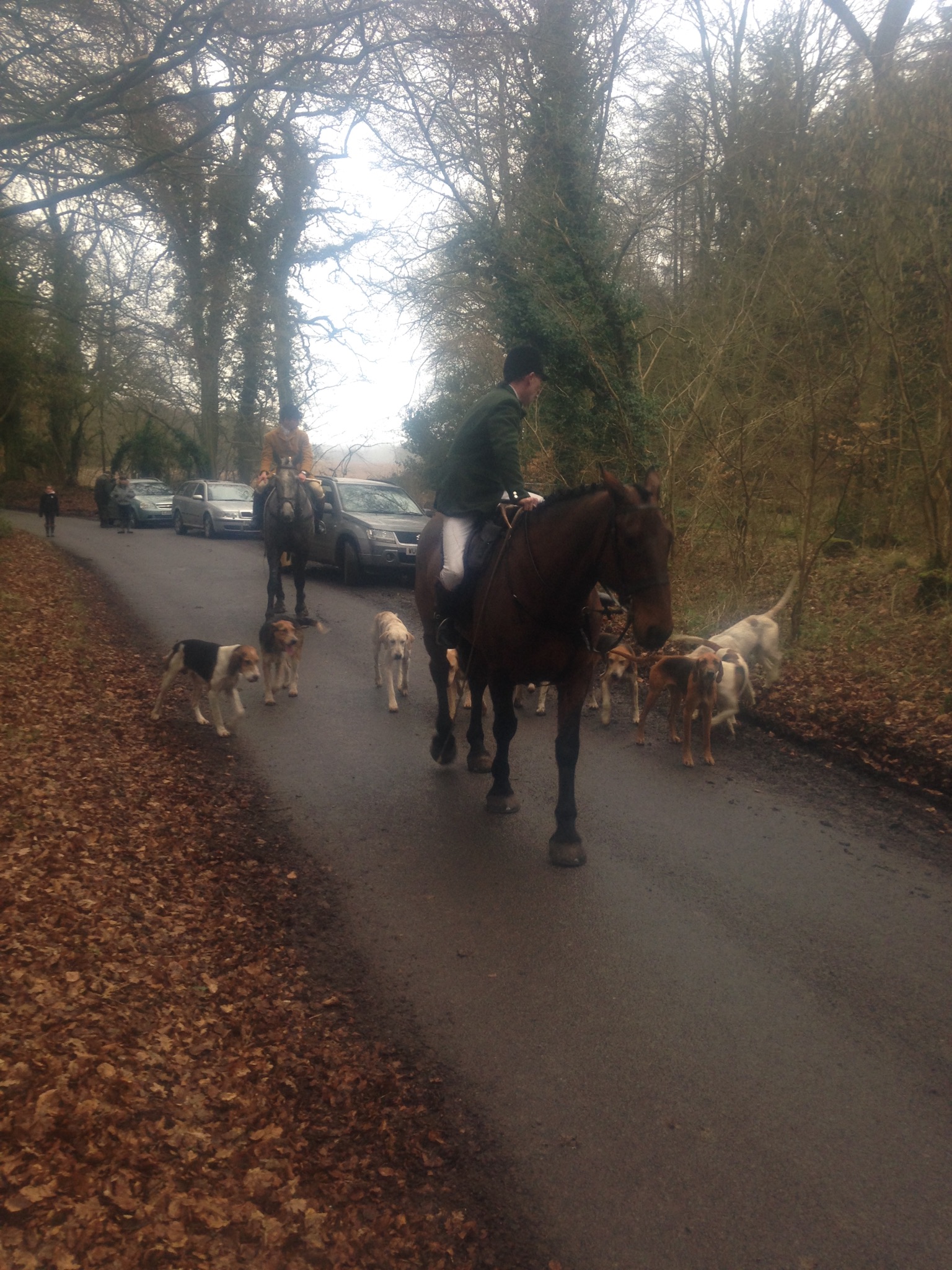 Staff College & RMS Sandhurst Draghounds helping the Kimblewick Hunt out on 210217. This was the day when Hounds Off volunteers learnt that the Buckinghamshire-based Kimblewick Hunt hounds had been infected with bovine tuberculosis.
Staff College & RMS Sandhurst Draghounds helping the Kimblewick Hunt out on 210217. This was the day when Hounds Off volunteers learnt that the Buckinghamshire-based Kimblewick Hunt hounds had been infected with bovine tuberculosis.
It has just been confirmed that the Kimblewick Hunt hounds have contracted bovine tuberculosis. Hounds Off now calls for the immediate blanket suspension of all hunting by all packs of hounds pending further information and enquiries.
That hunting with hounds poses a biosecurity risk, especially in relation to spreading bovine tuberculosis, comes as no surprise. We have been raising this issue for some time now. Confirmation that a pack of registered foxhounds in Buckinghamshire has contracted the disease should set alarm bells ringing. The question marks surrounding hunting and biosecurity, the risks which hunting with hounds pose to farm animal health, just got real and serious.
It is surely inconceivable that the self-styled “Guardians of the Countryside” can carry on like normal - or is it? As this scandal unfolds we will all be able to judge for ourselves who has the best interests of animal welfare and wildlife conservation at heart.
Hounds Off learned of the Kimblewick Hunt hounds contracting bovine tuberculosis on February 21st 2017. Here is how it happened:
Acting on information received, a small Hounds Off team recently monitored two meets of the Kimblewick Hunt in Berkshire near to where, last season, their hounds ran through a private garden. Our job was to protect this land forbidden to hunting.
On Valentines Day the meet was near Compton, a village not far from Junction 13 of the M4. It was a poorly attended hunt. We counted less than twenty riders, half a dozen car followers and three quad bikes. Twice hounds found a scent and went on cry, both times the chase ended inconclusively after five minutes with us in close attendance, cameras ready, at the sharp end. The second time hounds were running all over the road at Applepie Hill in a dodgy combination with narrow, undulating bends and fast traffic. They packed up mid afternoon and, from a monitoring perspective, we were pleased. The property we set out to protect was never in danger. One thing confused us though. The Kimblewick Hunt jacket is mustard coloured but the Huntsman on this day was wearing green. We asked around our contacts but nobody could explain.
On February 21 we returned to the Kimblewick who were hunting between Compton and Streatley. From the meet hounds took off after some deer, ran over the hills and far away. There was much hanging around and waiting. We were parked on a by-way near the village of Aldworth, watching through binoculars. A hunter wearing the Kimblewick mustard jacket disappeared after the hounds but the man in charge, the chap trying to gather hounds by calling with his voice and horn, was wearing green. Through the binos we recognised him from the week before.
Presently a blue Suzuki pulled up behind our vehicle and a lady hunt follower came over to say hello. Her name was Mary and we chatted. Mary was clearly unaware of who we were or why we were there. First thing we asked was who is the Huntsman wearing green? Mary informed us that he was Luke Chatfield from the Staff College & RMA Sandhurst Draghounds. Then she told us the reason why he was hunting and it was hard to believe!
According to Mary, the Kimblewick hounds had contracted bovine tuberculosis and the whole season “has been a write-off.” Their scheduled meets, she said, have been taken by visiting packs. On Feb 21 she said it should have been one of the Devon hunts but they pulled out at the last minute so the Draghounds, who are quite local anyway, filled in. Mary let slip that twenty-six of the Kimblewick hounds had been put down just last week.
Draghounds do genuinely hunt an artificial scent so we asked Mary what exactly was being hunted on this day; an artificial drag, fox-based trail or live quarry? She said that “accidents happen” and that she intended to stay out well into the afternoon. We know a bit about hunting and observed that things often hot up around 3pm. “Ah yes, the Three O’Clock Fox,” purred Mary with a knowing smile.
Mary said that the Duke of Beaufort Hunt was guesting on Saturday 25 Feb at Kingston Blount to finish this disastrous season, which normally runs into April. We chatted a bit more then, with the lull ongoing, she returned to sit in her car.
Efforts were still being made in the distance to gather scattered hounds and resume hunting. Presently an elderly chap walked into view and stopped to compare observations too. He was called John and, independently, confirmed that the Kimblewick hounds had contracted bovine tuberculosis. He said how they contracted bTB was “a mystery” but reckoned the “Ministry” were looking in to it.
“It’s all new,” conceded John, “the first time ever.”
Realising the profound implications for hunting if what we had just been told was officially confirmed but playing it cool, we talked about the poor show so far and wondered why the hounds were allowed to get away on the deer. Then John walked to Mary’s car and they wagged chins for a bit.
After that we were pleased to confirm that it was genuine draghunting, not fox hunting, which ensued. Apart from a dodgy five minutes when we were surrounded by estate workers, lads on quad bikes and one who sat on our bonnet to obstruct legitimate passage along a by-way (which diffused when an actual by-way sign right next to us was pointed out), it was all very half-hearted.
Immediately after the hunt had finished we put in a Freedom Of Information request to DEFRA regarding the Kimblewick revelations, then got stuck in to investigating. We soon discovered that in 2011 Irish hunting hounds were found to have been found infected with bTB.
Three days later, on Friday February 24, Hounds Off received information of an anonymous email sent to an anti hunting campaign group which, we were told, contained three salient points:
1. The Kimblewick Hunt hounds contracted bTB from eating infected cattle flesh.
2. 40 hounds have been destroyed in the last 10 days.
3. The Masters Of Foxhounds Association (MFHA) is covering the whole thing up.
Since then we have worked with the League Against Cruel Sports and Daily Mirror journalist Ben Glaze to verify as much of the above as possible. This is not our ‘story’ nor theirs. It belongs to all of us who care about wildlife conservation and animal welfare. If you are reading this and have a question, ask it. One thing is for certain - there is much more which remains unclear and needs to be found out!
© Joe Hashman
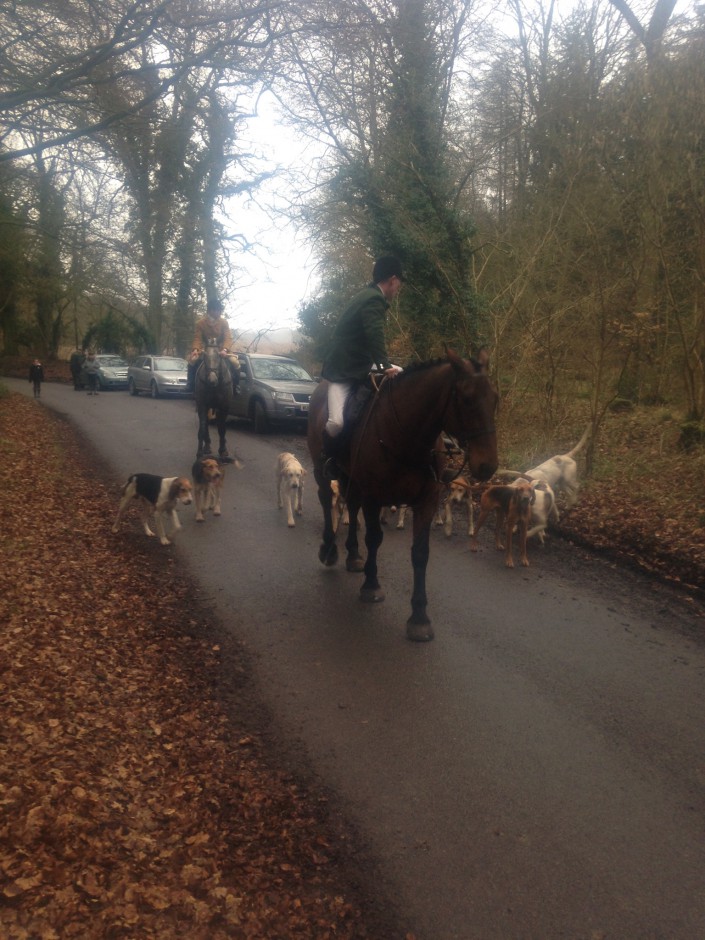
Staff College & RMS Sandhurst Draghounds helping the Kimblewick Hunt out on 210217. This was the day when Hounds Off volunteers learnt that the Buckinghamshire-based Kimblewick Hunt hounds had been infected with bovine tuberculosis.
Editor's picks
- Best Casino Sites Not On Gamstop
- Online Casinos Not On Gamstop
- UK Betting Sites
- UK Online Casinos Not On Gamstop
- Gambling Sites Not On Gamstop
- Non Gamstop Casinos
- Sites Not On Gamstop
- Non Gamstop Casino Sites UK
- Non Gamstop Casino Sites UK
- Non Gamstop Casino Sites UK
- Non Gamstop Casino Sites
- Top Casino Sites UK
- Casino Not On Gamstop
- UK Online Casinos Not On Gamstop
- UK Casino Not On Gamstop
- Casino Sites Not On Gamstop
- UK Casino Sites Not On Gamstop
- UK Online Casinos Not On Gamstop
- Best Betting Sites
- Casinos Not On Gamstop
- Best Non Gamstop Casinos
- Betting Sites Not On Gamstop Uk
- Sites Not On Gamstop

